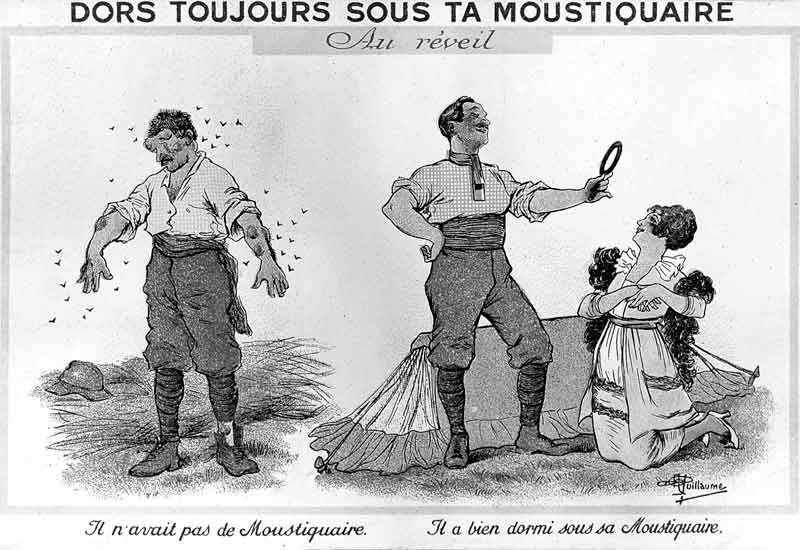Mosquitoes are the world’s most hated insect. In many areas they carry deadly diseases; even in places where mosquitoes are technically harmless, the itching from their bites can drive you crazy. Nothing ruins a summer’s evening faster than a swarm of bloodsuckers.
An effective mosquito repellent is a must if you’re spending time outside in warm weather. There are dozens of different formulations available, from scary high-DEET insecticides to fragrant herbal concoctions.
The trouble with chemical repellents is that you have to keep re-applying every few hours, which can be a real inconvenience if you’re spending long periods of time outdoors.
And there’s always the chance of missing a spot, which means mosquitoes will make a feast of your single bare patch of skin.
Covering up can help to reduce bites – long sleeves, trousers, closed-toe shoes. But just covering up isn’t enough: thin or stretchy fabrics won’t protect you.
To prevent mosquito bites, dress wisely. You can either block the mosquitoes physically, or use a chemical barrier which repels them.
 it takes more than a cork hat to protect yourself from mosquitoes
it takes more than a cork hat to protect yourself from mosquitoes
 1) Fabric
1) Fabric
Knitted fabrics contain millions of tiny holes which can be easily pierced by a mosquito’s sharp proboscis. Most athletic clothes (like t-shirts and base layers) are made from knit fabrics, which means standard outdoors gear may not protect you from bites.
Tough woven textures provide better protection; the firmer the fabric the better. A tightly-woven nylon or polyester shirt will physically block the mosquitoes from getting to you.
The drawback is that this sort of fabric can feel quite stiff and uncomfortable, so look for fabrics which contain 5-10% spandex or elastane for stretch.
2) Style
The ultimate mosquito barrier is woven polyester. But this can be quite sweaty, so make sure your clothing has extra ventilation to improve breathability: look for underarm mesh, half-zips, and roll-up sleeves, as well as wicking technology which pulls sweat away from your skin.
3) What you should know about color
There’s a common myth that mosquitoes will be attracted to bright colors, but this is only half true. Male mosquitoes feed on flowers; it’s the female mosquitoes which suck blood, and they generally hunt by scent rather than sight.
Splashy clothing might make males think you are a colorful plant, but they will buzz around you harmlessly.
Bloodsucking females follow the smell of your sweat or the carbon dioxide on your breath; they wouldn’t notice your clothing if you wore a Carmen Miranda headdress.
Dull-colored clothing can help to stop insects swarming around you, but it won’t make you any less likely to be bitten.
4) Headnets and hats
In areas where the bugs are really dense, a headnet is a lifesaver. It not only prevents bites, but also stops bugs flying into your eyes and mouth.
Nets such as the best-selling Qibox headnet, are commonly held in place by a firm-brimmed hat at the top and a ring of metal at the bottom, to keep the netting away from your face.
An elasticated bottom stops creepy-crawlies getting under the net from below. Nets come in various thicknesses: mosquito netting is loosely woven, whereas midge (no-see-um) netting is finer to prevent smaller bugs from squeezing through.
Unless midges are a real problem in your area, mosquito netting is usually a better bet.
The plastic in the stiff hat brim can make you sweaty, and the looser weave of mosquito netting makes it cooler as well as easier to see through.
5) Inbuilt mosquito repellent
If you’re sick of just blocking mozzies and want to actively repel them, try mosquito-repellent clothing. It’s used by the US Army in tropical areas, as they don’t want their soldiers laid low by malaria or swatting bugs when they’re trying to creep unseen through the undergrowth.
The active ingredient in mosquito-repellent clothing is a powerful insecticide called permethrin. Odorless to humans, it repels not only mosquitoes but a variety of other biting insects, from midges to ticks.
Clothes are imbued with permethrin in the factory: the beneficial effects are said to last for up to 70 washes, which is the lifespan of an average garment.
“when permethrin is infused to fabric the bug repellent is more effective and longer-lasting when compared with spraying on the skin”
Mosquito-repellent clothes offer 99% protection against mosquitoes for the areas of skin they cover. Permethrin not only repels mosquitoes, but kills them dramatically if they do land.
Your clothes will protect the skin for a short distance around – so a short-sleeved shirt, for example, will also stop your neck and forearms from getting bitten.
You will still need repellent on exposed areas of skin, but you don’t have to worry getting nibbled underneath your collar or cuffs.
“permethrin is the only pesticide approved by the EPA for pre-treated fabrics”
6) How to care for mosquito repellent clothing
The great thing is that these clothes are easy to care for; you don’t need to take any steps to preserve the protection, just chuck them in the washing machine with a standard laundry detergent.
Dry-cleaning should be avoided as will remove the protective coating – but not many people dry-clean their mosquito nets anyway.
7) Do you want a physical or chemical barrier?
It really depends on your personal preferences, and how bad the bugs are in your area.
The big benefit of mosquito-repellent clothing is that you can use less insect repellent on your skin – you’ll need to apply it only to the exposed areas.
It’s a great choice if you have sensitive skin, because the chemicals stick to your clothes rather than your skin. The permethrin soak is applied to clothes after they have been finished, and it doesn’t affect the feeling of the fabric or reduce its moisture-wicking properties.
On the other hand, these clothes are expensive – about $10 more than standard travel gear, which isn’t cheap to start with – and the repellent effect decreases slowly with washing.
Permethrin is also extremely deadly to aquatic life. Though the amount in a single item of clothing is small, some consumers worry about the cumulative effect of permethrin soaking into rivers from hikers’ gear.
8) Should you wear treated clothing from head to toe?
The effect of permethrin is much more noticeable on thin fabrics, such as t-shirts. Clothes like jackets and hiking trousers are usually thick enough to discourage mosquitoes, whether or not they have been treated.
If you like the idea of mosquito-repellent gear but don’t want to replace your whole travel wardrobe, consider getting chemically-treated hats or wristbands. Sweat and friction mean that the face and hands are the hardest areas to protect, so a fug of insecticide from your clothes will help to prevent bites.
You can buy permethrin-treated socks, such as these BugsAway Purdom Hiker Socks which are an excellent choice even if you choose not to use the repellent on the rest of your clothes. They repel ticks and other nasty bugs too.
By their nature, socks have to be made of stretchy knitted material, and there’s no way you can wrap a physical barrier like woven polyester around your feet.
This means that you ankles are like an all-you-can-eat buffet for insects. Insecticide-treated socks will not only stop bites, they will also discourage ticks from making their way up your legs.
9) Are there other options?
Commercially-made mosquito repellent clothing tends to be designed for travellers and hikers. Everything is sturdy and practical, but there’s a fairly limited range of styles and colors.
If you don’t like what’s available, it’s possible to mosquito-proof any item of clothing by soaking it in diluted permethrin at home. The effect will last for 5-6 washes, and works for any type of fabric.
You can also buy the chemical in a spray bottle to spritz onto your clothes: this will only last for a couple of washes, but it’s a quick and easy treatment.
10) What else do you need to consider?
It sounds obvious, but many people forget that mosquito-blocking clothing also needs to be comfortable. Whether you choose chemical treatments or a physical barrier, make sure that the clothes are breathable and easy to wash.
Present-day mosquito repellent clothing has come a long way in terms of sporting breathable, odor-free fabric that feels soft to the skin and does not get sticky from sweating .
Look for features like fast-drying, moisture-wicking fabrics, mesh and zips for ventilation, and SPF protection for sunny days.
The Dalai Lama famously said,
“Anyone who thinks they are too small to make a difference, has never slept in a room with a mosquito.”
The little pests get everywhere. This summer, you can rest easy, knowing that your clothes will protect you from bugs and bites.
Recommended products
Popular mosquito-proof clothing choices on Amazon are Coghlan’s Bug Jacket and Coghlan’s Bug Pants.
2 Tips for extra safety
If you’re not fully protected by wearing quality mosquito protection clothes, make sure to;
- use DEET (it’s safe when used appropriately) and
- sleep under a good mosquito net when camping. You will be glad you did:

Images, Wikipedia and Wikimedia Commons.

Actually dark colored clothes with attract mosquitos versus light colored. That is why the center of a mosquito trap is black. So color is a variable.
Can I spray the permethrin on my Couglan’s Bug Jacket and Pants? The Sawyer Permethrin spray I was looking at says not to have any contact with skin. But if you spray it on mosquito net clothing, won’t that touch your skin once you wear it? Also, is permethrin deadly to cats?
Yes- very deadly to cats:
https://catfriendly.com/be-a-cat-friendly-caregiver/cat-friendly-safe-home/toxins-poisons/permethrin-poisoning/